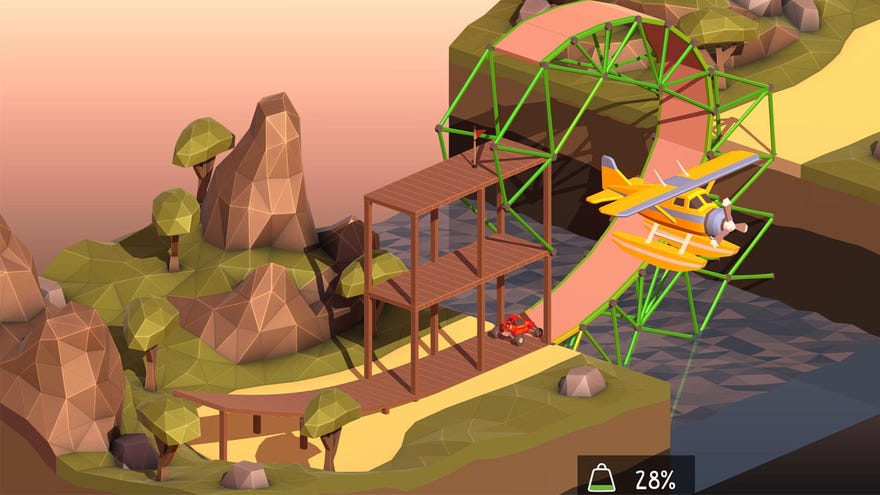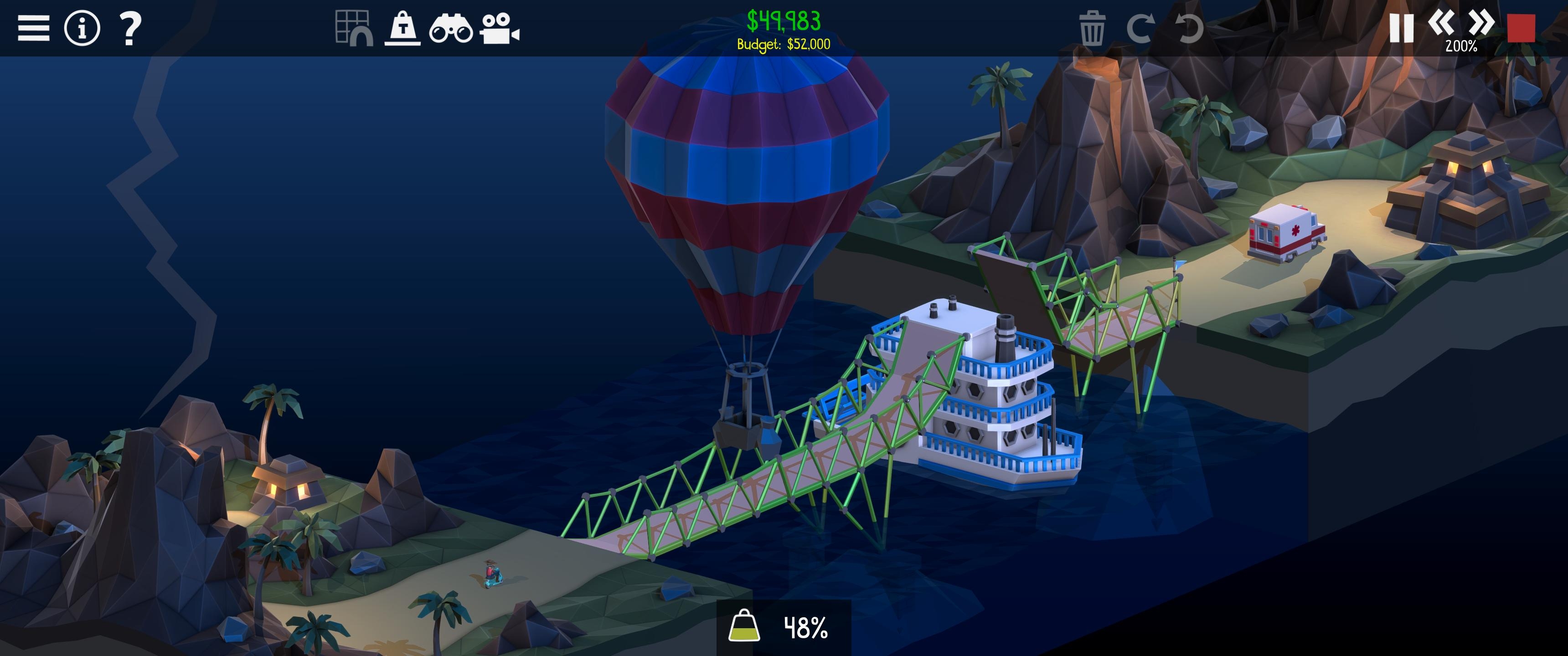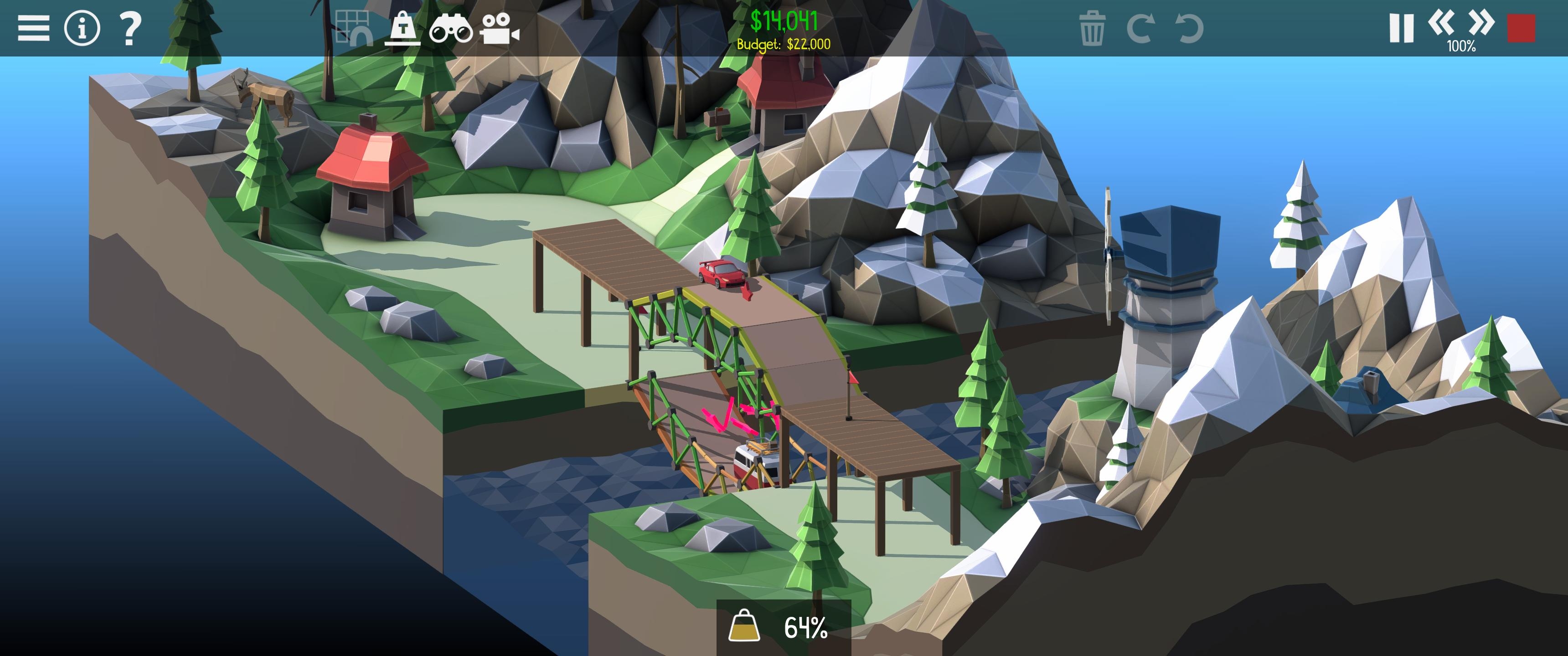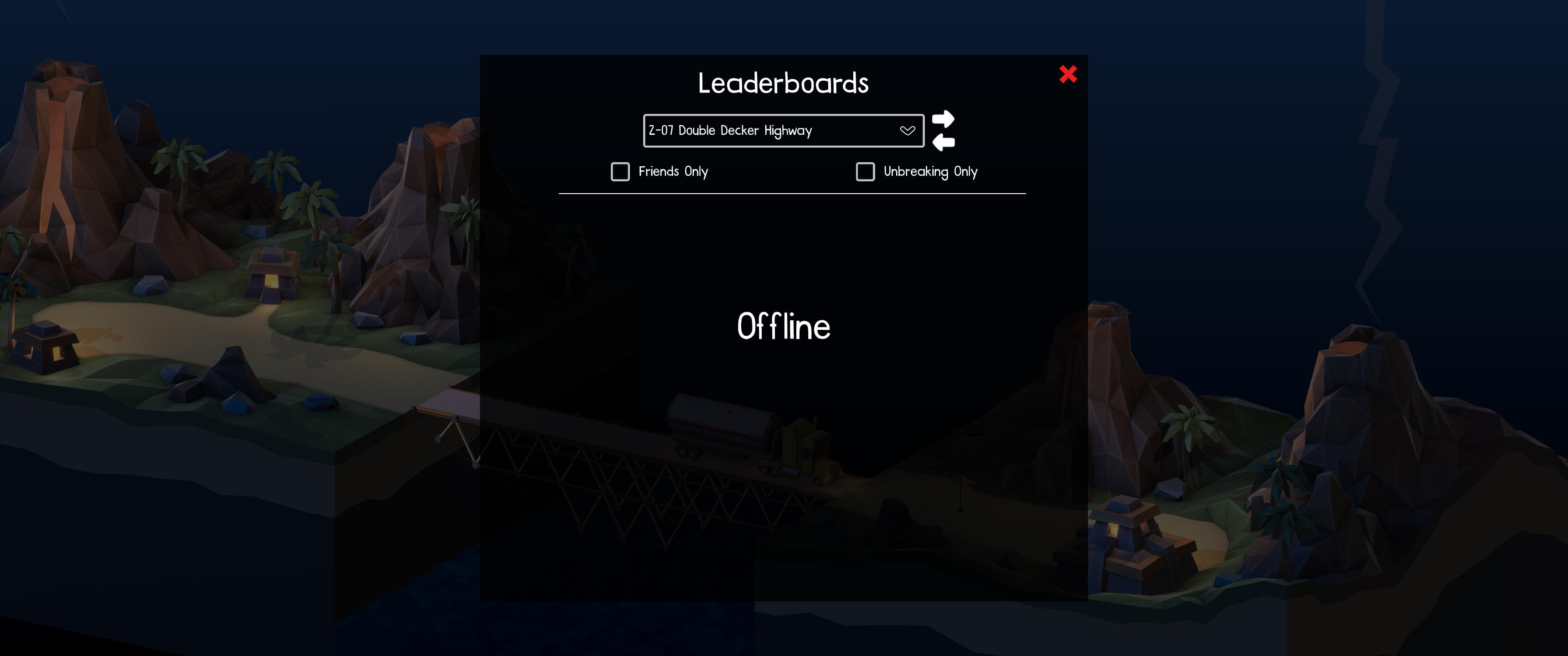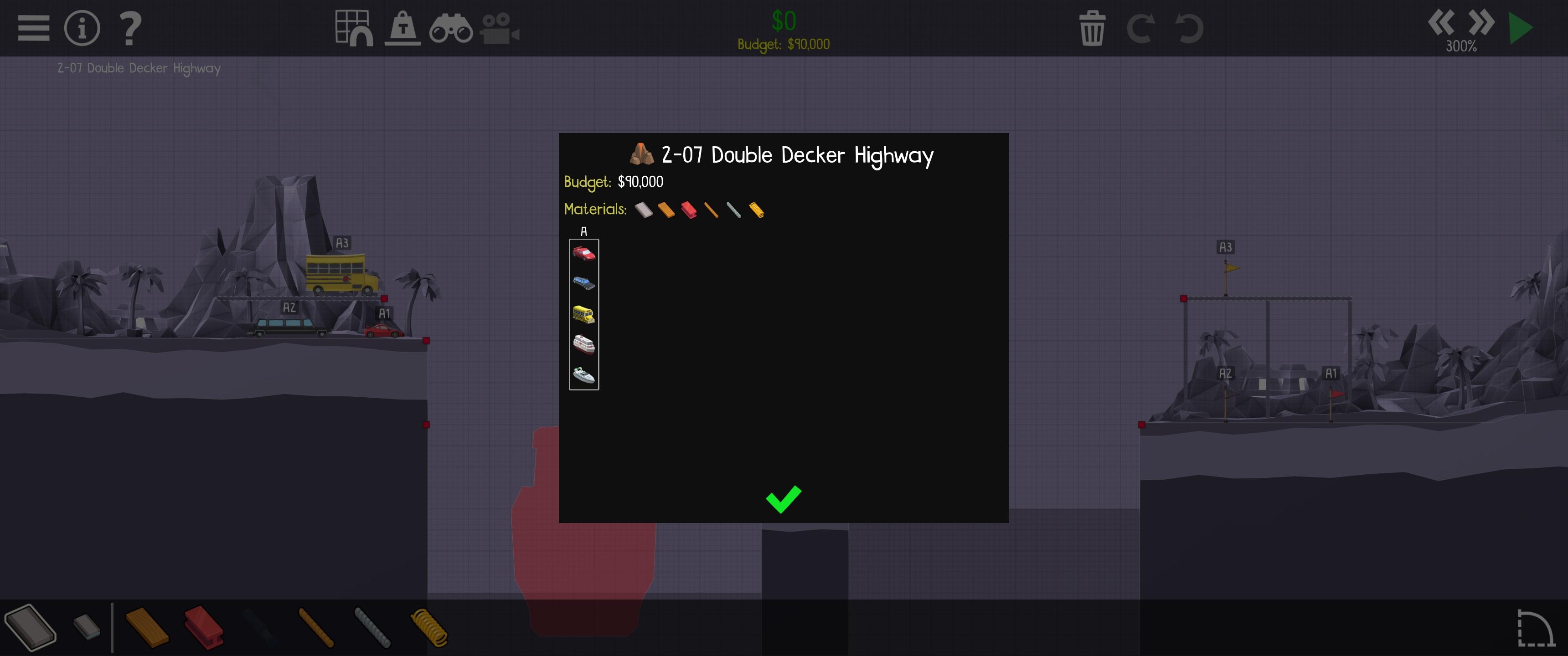Poly Bridge 2 review
A bridge not far enough
I'm so interested in how expectation affects our experience of games. Whether it's from over-ambitious promotional materials, peculiarly unhelpful reviews, or completely misreading the game's description before buying it, what we're hoping for before we start really colours how we receive the game. I was convinced that Poly Bridge 2 was a goofy physics puzzler, something somewhere between Totally Accurate Battle Simulator and Crayon Physics Deluxe. Poly Bridge 2 is nothing like that. It is - despite the apparent levity in the screenshots you see either side of these words - a proper grown up game for proper serious bridge building enthusiasts.
Which is also to say, 2016's Poly Bridge and its just-released follow-up are also extraordinarily similar to 2013's Bridge Constructor, which in turn bore rather a lot in common with the various iterations of Alex Austin's Bridge Builder. I believe the parlance used when a game looks quite so like another game is to say that they are in the "Bridge Builder genre". Anyway, whatever its progenitor, Poly Bridge was an enormously popular game. I shall confess to you immediately that I am not familiar with this particular sector of gaming, and as such have been attempting to sink myself deep within it for the purposes of this review. Bearing this in mind, I have also provided the following template for your complaints.
Dear Rock Paper Scissors,
I am writing to complain in the strongest possible terms about your selection of the so-called "journalist" John Walker to review Poly Bridge 2 on your website that I definitely read all the time and haven't just happened upon on this occasion. What is the point of having someone who is unfamiliar with a game do a review of it? How is this possibly supposed to help readers who are already enormous fans of the series and pre-ordered it and been playing it for days now? This provides no cathartic agreement and validation of the opinions of a tiny minority of readers.
And more besides, Walker clearly demonstrates his lack of expertise in this area when he incorrectly states [please insert all semantic corrections here].
Yours disgusted,
[Your name]
Poly Bridge is about safely constructing a means of crossing a gap for various vehicles. One might call this Bridge Construction, for instance. Or Bridge Building. In a sort of mock-blueprint, you draw out the structure for your [opens thesaurus.com] vehicular scaffold, choosing materials that will hopefully hold it up against the stresses and strains of [glances] wheel-machines. Then you run the simulation and see if the cars, buses and trucks boringly drive to the other side, or more entertainingly plop into the water below.
I am, technically, a grown up. So this is fine. I can do this. I may not be a structural engineer by training, but I can follow simple instructions. Which is, to accidentally do some proper reviewing for a moment, something peculiarly absent in Poly Bridge 2.
Having played both, because I am diligent, it's striking that Poly Bridge 2 feels like a bit of a backward step in various areas when compared to the four-year-old previous game. Along with many little details that feel less refined, less feature-rich, this is most damningly shown by a non-tutorial that blatantly assumes you're a pro at the first game. The original had some significant issues with its own far more extensive tutorials, as Pip [RPS in peace] keenly observed way back when, in failing to actually teach you how to use its myriad features. But boy oh boy, this time out they really scrapped all that business, and just dump you in it from the off. One little cluster of instructions, in which it deliberately tells you to do it the wrong way twice in a row, and then it just asks you to already know how to use the UI, be familiar with the wildly different construction rules for different materials, and doesn't bother to mention that it's changed the buttons for moving the camera around.
Of course, to aficionados this will not be a problem, familiar as they will be. Such issues will be hand-flapped away as fussing. For them, this is more of the game they've loved, and that's always nice. But to anyone coming in new, it's alienating.
Instead it's added a madcap collection of tips, which are in a muddled order, unintuitive, and no replacement for a guided tutorial. By level 1-08 it's asking you to teach yourself about rope and cable support. After that it just adds in the game's new element, springs, without mentioning them. Sure, I can figure this stuff out, but it's such an abstruse way to introduce new features. It also become far larger a problem when you're asked to complete a level by raising hydraulics at specific points, and the meagre instructions in a pop-up hint screen read thus:
"The hydraulic container allows you to decide whether hydraulics or split joints will activate or not during each hydraulic phase. First click on the phase you would like to adjust, then click on the hydraulic or split joint you would like to activate or deactivate during that phase."
Phase? No explanation of that. Or how they're decided. Or how you click on them. Again, I figured it out in the end, but it's a clumsy and pretty rude way to proffer your game.
It then absolutely doesn't help that my rather nicely put together, under-budget bridge, was ever-so-slightly "too steep" for the campervan that was trying to cross it, but rather than noticing this fail state, the simulation just runs on for infinity as the van endlessly grinds its tyres into the road that it absolutely flat-out should be able to drive along. This is always the case: the game can only recognise fail states that see your bridge collapse and the vehicle get wet - otherwise you can sit watching a lorry spinning its wheels forever, wondering if it might incrementally make it over the ludicrously tiny bump upon which it's beached.
Other features that stood out from the first game appear completely absent or broken in the sequel. The little radial menu for selecting materials seems completely gone. The super-cute screen for picking levels is replaced by a dull list of text. Complete a bridge in PB1 and you'll see complicated graphs that show how well you performed compared to everyone else in the world. After completing a bridge in PB2, I'd mostly see a black box appear with loading circles, that eventually concluded with a message reading "Offline", some six days after release. And oh gawd, the nauseating lift music.
The "Tutorials" menu contains a grand total of two entries, everything else relying on the very poorly worded tips screens, that vaguely allude toward what new items might do, or as above, describe it abysmally. Or even more bizarrely, just offer up something completely irrelevant. On one level in the third world (of four) that had me stumped, all it had to offer was instructions on hydraulics, which were - er - not available in that level.
Presentation remains so strange too. Levels are introduced with big black squares where surely text was meant to appear? And this time rankings in the main menu just get you an "Offline". The Workshop is completely empty. I've checked back twice now to see if this is in Early Access. It isn't.
Yet, I get it. I get why this is doing great numbers, and is all over YouTube with squillions of views. Once you've got to grips with its mechanics and contents, you can start to improvise around its requests, choose whether to approach a scenario with focused efficiency or silliness. Setting up crazy bridges made of springs and having them work is a satisfactory experience, and makes for great streaming. In fact, if anything, I've found Poly Bridge 2 to be a far more fun game to watch other people playing than it is to play myself. Building the bridges is a fiddly, repetitive act, the necessity to build triangles of wood and steel for every construction a constantly dull experience. Even copying and pasting chunks of triangles barely speeds things up, with all the little adjustments necessary. (I totally wrote that last sentence to ruin someone's angry email.)
It works best when it sets you a relatively simple bridge to build - say getting two cars to cross independently and finish at different levels - but makes the budget incredibly tight. Then you can feel in control, construct something that works but is over-budget, and then begin refining, cutting corners, or better, trying some crazy thing with springs and ropes to replace the expensive steel. Picking away at a working design to save money works out to be a lot more fun than the blank canvas and no guidance most puzzles offer.
I do wish it could have been the game of my expectations, a far more fun-based, silliness-encouraging, physics-me-do. Instead it sits in a slightly awkward space, partly delivered with the frown-faced seriousness of one of those italicised-titled simulation applications, but with the potential for Twitchable goofball antics. The game itself only appreciates efficiency, tidiness, meticulous sticking to budgets, with no recognition of eccentric designs or madcap solutions, such that it always feels like you're doing it wrong when you're having fun.
But I know that people are digging this, so what do I know? To me it feels far more like an expansion pack than a whole new game, slightly improving the cutesy graphics and adding in a couple of extra construction materials, but even then it all overlaps a little too closely with the original. A sequel to a game that already looked awfully similar to another series seems like something that should have iterated a great deal further by now. I certainly recommend checking out people's most elaborate and daft bridges on YouTube - as for creating them yourself, it's harder to get excited about.
